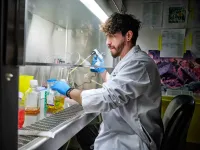Hassles with child car seats linked to unsafe child passenger behaviors
2021-03-03
(Press-News.org) Parents who reported more hassles using a child car seat or booster seat - such as the child is uncomfortable or having to make multiple trips in a day - were less likely to follow recommendations from the American Academy of Pediatrics (AAP) on child passenger safety, according to a study published in the journal Academic Pediatrics.
Researchers obtained information about transportation safety behaviors and 20 hassles when using child car seats among 238 socioeconomically and racially diverse parents of children 1 to 10 years of age. Eighty percent of parents reported at least a little bit of a problem with one or more of the hassles. On average, parents had a problem with five of the hassles. Parents who were not following the AAP recommendations indicated the hassles were bigger problems.
Half of parents reported at least one behavior that went against the AAP recommendations, such as not always using a child car seat or allowing their child to travel without buckling up. For each additional hassle a parent identified, there was a 14 percent increase in the odds that their child was not consistently using a car seat and an 11 percent increase in the odds of their child traveling unrestrained.
"Our study shows that hassles with car seats are common and associated with unsafe practices," says senior author Michelle Macy, MD, a pediatric emergency medicine specialist at Ann & Robert H. Lurie Children's Hospital of Chicago and Associate Professor of Pediatrics at Northwestern University Feinberg School of Medicine. "Parents need to make car safety a consistent priority. Planning for extra time to be sure everyone is buckled up and not bending the rules helps children know safety isn't negotiable. When kids know that riding in a car seat is a strict rule, they better accept the situation and don't fuss as much."
Injuries sustained in motor vehicle collisions are a leading cause of death for children 1 to 10 years old. There is extensive evidence that young children are best protected against severe injury and death in crashes when they use the recommended child safety seat for their age and size. This evidence serves as the foundation for guidelines published by the AAP.
To optimize safety in passenger vehicles for children, the AAP recommends rear-facing car safety seats as long as possible, forward-facing car safety seats from the time they outgrow rear-facing seats through at least 4 years of age for most children, belt-positioning booster seats from the time they outgrow forward-facing seats until they are tall enough to fit in an adult seat belt, around 4 feet 9 inches and between 8 and 12 years of age for most children, and then lap and shoulder seat belts after booster seats.
The study findings and the child car seat hassles list could serve as basis for developing a risk assessment tool that clinicians could use to identify problems parents face and help them strategize on how to overcome the obstacles to keep their children safe when traveling in a car.
"Meanwhile, clinicians can ask parents about specific hassles with child car seats and offer tips on managing these problems," says Dr. Macy. "It is critically important to reinforce with parents child passenger recommendations and help them achieve consistent safety practices."
INFORMATION:
Dr. Macy received funding from the Eunice Kennedy Shriver National Institute of Child Health and Human Development (K23 HD070913).
Research at Ann & Robert H. Lurie Children's Hospital of Chicago is conducted through the Stanley Manne Children's Research Institute. The Manne Research Institute is focused on improving child health, transforming pediatric medicine and ensuring healthier futures through the relentless pursuit of knowledge. Lurie Children's is ranked as one of the nation's top children's hospitals by U.S. News & World Report. It is the pediatric training ground for Northwestern University Feinberg School of Medicine. Last year, the hospital served more than 220,000 children from 48 states and 49 countries.
ELSE PRESS RELEASES FROM THIS DATE:
2021-03-03
Neurodegenerative disorders such as Parkinson's and Alzheimer's disease are in the firing line after researchers identified an attractive therapeutic drug target.
An international collaboration, co-led by University of Queensland researchers, has isolated and analysed the structure and function of a protein found in the brain's nerve fibres called SARM1.
Dr Jeff Nanson said the protein was activated when nerve fibres were damaged by injury, disease, or as a side effect of certain drugs.
"After a damaging incident occurs, this protein often induces ...
2021-03-03
Fireworks are used in celebrations around the world, including Independence Day in the U.S., the Lantern Festival in China and the Diwali Festival in India. However, the popular pyrotechnic displays emit large amounts of pollutants into the atmosphere, sometimes causing severe air pollution. Now, researchers reporting in ACS' Environmental Science & Technology have estimated that, although so-called environmentally friendly fireworks emit 15-65% less particulate matter than traditional fireworks, they still significantly deteriorate air quality.
Fireworks displays can cause health problems, such as respiratory ailments, because they ...
2021-03-03
Wine lovers recognize that a perfectly paired wine can make a delicious meal taste even better, but the reverse is also true: Certain foods can influence the flavors of wines. Now, researchers reporting in ACS' Journal of Agricultural and Food Chemistry have explored how lipids -- fatty molecules abundant in cheese, meats, vegetable oils and other foods -- interact with grape tannins, masking the undesirable flavors of the wine compounds.
Tannins are polyphenolic compounds responsible for the bitterness and astringency of red wines. Wine testers have noticed that certain foods reduce these sensations, improving the flavor of a wine, but scientists aren't sure why. Some studies have ...
2021-03-03
DALLAS, March 3, 2021 -- American Indian people with atrial fibrillation (AFib) had the highest risk of non-hemorrhagic stroke when compared with people in other racial and ethnic groups, and they also experienced the highest overall risk for stroke even without atrial fibrillation (AFib), according to new research published today in the Journal of the American Heart Association, an open access journal of the American Heart Association.
"In previous research, we have confirmed that American Indian individuals, when compared with those in other racial or ethnic groups, have the highest risk of atrial fibrillation, which is a quivering or irregular heartbeat that can substantially increase the risk of blood clots and stroke," said lead study ...
2021-03-03
DALLAS, March 3, 2021 -- The association between race and ethnicity and specific characteristics of some U.S. counties may have a significant impact on death rates related to cardiovascular disease, according to new research published today in the Journal of the American Heart Association, an open access journal of the American Heart Association.
Cardiovascular disease is the leading cause of death in the U.S. across all racial and ethnic groups, and disparities in cardiovascular outcomes for racial and ethnic minority groups have been documented extensively. This study presents a detailed analysis of county-level predictors of cardiovascular ...
2021-03-03
The first proof of the origin of malignant rhabdoid tumour (MRT), a rare childhood cancer, has been discovered by researchers at the Wellcome Sanger Institute, the Princess Máxima Center for Pediatric Oncology in the Netherlands, and their collaborators.
The study, published today (3 March 2021) in Nature Communications, found that MRT arises from developmental cells in the neural crest* whose maturation is blocked by a genetic defect. The team also identified two drugs that could be used to overcome this block and resume normal development, bringing hope of new treatments for the disease.
Malignant rhabdoid tumour (MRT) is a rare soft tissue cancer that predominantly affects infants. ...
2021-03-03
A robotics platform designed by Toronto researchers to screen thousands of COVID-19 samples at once has the potential to revolutionize how labs track the spread of viruses and other pathogens, according to new findings.
The END ...
2021-03-03
Wild pigs are often maligned as ecosystem destroyers, but a University of Queensland study has found they also cultivate biodiverse rainforests in their native habitats.
Dr Matthew Luskin has been researching the effect of native pigs in Malaysian rainforests and found their nests may be critical to maintaining diverse and balanced tree communities.
"We've shown that wild pigs can support higher diversity ecosystems and are not just nuisances and pests, thanks to a beneficial effect of their nesting practices," Dr Luskin said.
"Prior to giving birth, pigs build birthing nests made up of hundreds of tree seedlings, usually on flat, dry sites in the forest.
"As they build their nests, the pigs ...
2021-03-03
Researchers from the Icahn School of Medicine at Mount Sinai have identified a drug that works against depression by a completely different mechanism than existing treatments.
Their study showed that ezogabine (also known as retigabine), a drug that opens KCNQ2/3 type of potassium channels in the brain, is associated with significant improvements in depressive symptoms and anhedonia in patients with depression. Anhedonia is the reduced ability to experience pleasure or lack of reactivity to pleasurable stimuli; it is a core symptom of depression and associated with worse outcomes, poor response to antidepressant medication, and increased risk of suicide.
Ezogabine was ...
2021-03-03
In an analysis of nationwide data from the Veterans Health Administration, approximately one-quarter of individuals with kidney stones had a diagnosis of osteoporosis or bone fracture around the time of their kidney stone diagnosis. The findings are published in the Journal of Bone and Mineral Research.
Investigators identified 531,431 patients with kidney stone disease between 2007 and 2015, and they found that 23.6% of patients had a diagnosis of osteoporosis or fracture around the time of their kidney stone diagnosis. In patients with no prior history of osteoporosis or bone analyses before their kidney stone diagnosis, 9.1% ...
LAST 30 PRESS RELEASES:
[Press-News.org] Hassles with child car seats linked to unsafe child passenger behaviors



